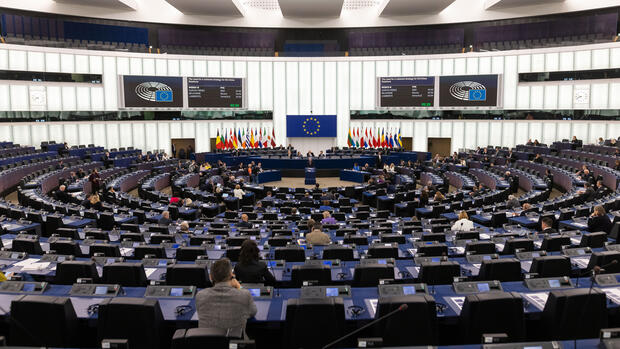Negotiations on the reform lasted almost two years.
(Photo: dpa)
Brussels Until the very end, the responsible MPs were not sure whether they would find a majority for what is probably the most important climate protection law in the world. Now, however, a large majority of the European Parliament members voted for the reform of the European Emissions Trading System (ETS).
The law regulates the maximum permissible CO2 emissions in important industries, such as electricity production. As a result of the reform that has now been decided, the amount of permitted CO2 emissions will fall even faster in the future. The aim is to make the industry climate-neutral by 2050.
“The EU will be the first major economy in which climate protection measures meet the goals set,” said EU Commission Vice-President Frans Timmermans.
After the vote in the European Parliament, the law still has to clear one last hurdle: it needs the approval of the EU Council, in which the governments of the member states are represented. Actually, this is considered a formality and the majority there as secured. However, there are doubts because a few weeks ago the federal government withdrew its approval of a law that had already been agreed at the last minute. At that time it was about the ban on new cars with combustion engines.
“In order to become independent of Russia and to keep prices under control in the long term, we have to say goodbye to fossil fuels,” said the responsible rapporteur Peter Liese (CDU). “And emissions trading is the central instrument for this.” Europe should not be de-industrialized, but European industry should be decarbonized. “Only in this way are we a role model for other parts of the world.”
>> Read here: Debate on the future of e-fuels: “With all due respect, this is complete nonsense”
Green climate politician Michael Bloss spoke of a “historic day for climate protection”. “The era of free pollution is over.”
Disputes with trading partners are foreseeable
In addition to the faster shortage of CO2 emission allowances, the reform envisages many other changes. CO2 emissions trading for petrol, diesel, heating oil and gas is to be introduced throughout the EU, as has been the case in Germany for several years.
Some of the income from this is to be returned to the citizens via a climate social fund, for example to promote the insulation of apartments and the purchase of heat pumps. The remaining revenues flow into the budgets of the member states, which they have to invest in climate protection measures.
>> Read here: Nuclear power 2.0: This is the future of nuclear energy
The introduction of a CO2 border adjustment (Cbam) was particularly controversial. Goods that were produced outside the EU in CO2-intensive processes and then sold in the EU are to be charged more. The border adjustment is a levy, the amount of which should always roughly correspond to the CO2 costs within the EU.
Trading partners of the EU criticize the instrument as protectionist. The World Trade Organization (WTO) has concerns about this. However, the EU sees it as crucial in order not to disadvantage its own companies in competition with foreign competitors.
Another new feature is that shipping companies have to pay for their CO2 emissions. For journeys to and from non-European ports, 50 percent of the emissions are included.
More: Compulsion to climate-neutral economy – This is how the tightened CO2 emissions trading works

